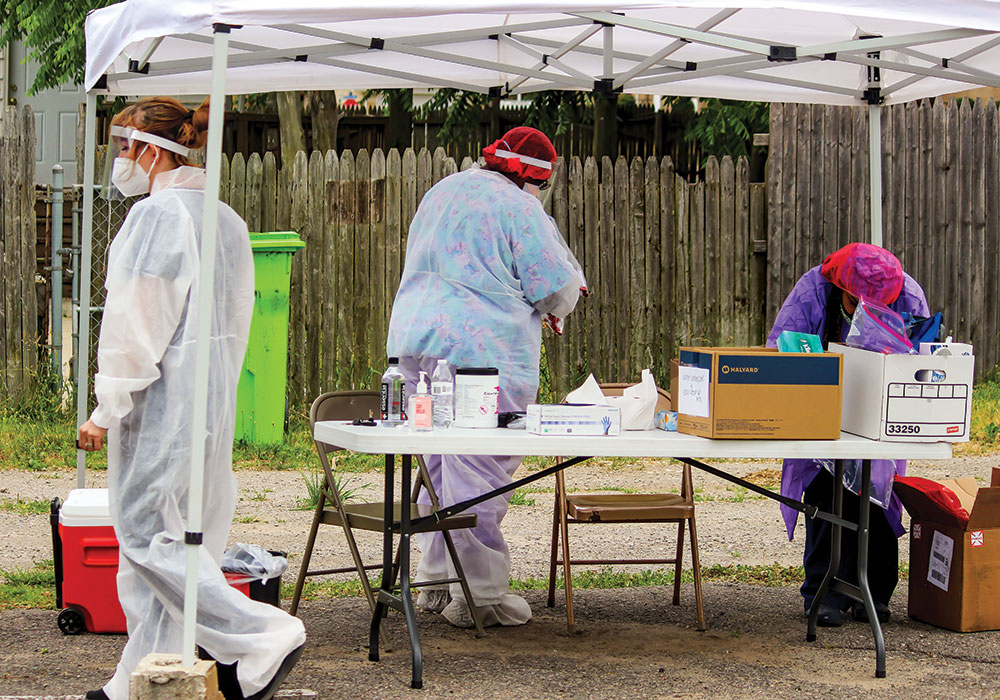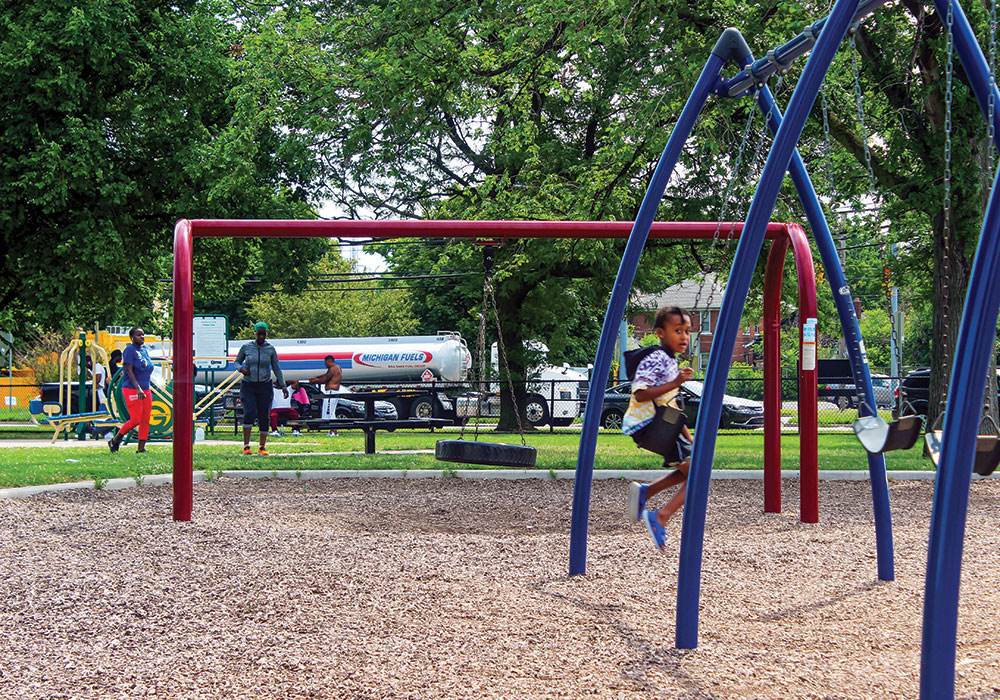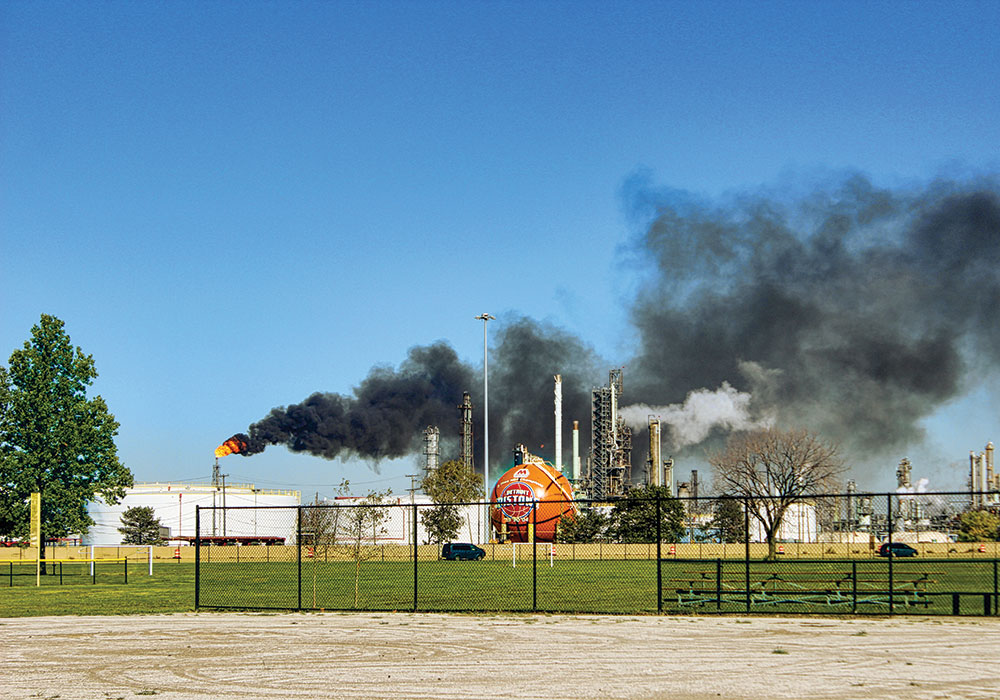Planning October 2020
'We Fight So Many Battles'
A Detroit neighborhood continues to suffer from 100 years of land-use decisions that put economic development before public health.

The Tri-Cities United community group organized COVID-19 testing in the heart of 48217 so residents didn't have to travel by public transportation to other parts of the city.
By Lisa Berglund, PhD
Photographs by Emma Lockridge
Updated March 23, 2021*
The interrelated challenges of environmental degradation and economic decline can create dangerous conditions for communities of color in shrinking cities. Detroit has long been considered a poster child for that struggle, but today, its image is slowly changing. Publicly subsidized reinvestment of billions of dollars has brought a new light-rail circulator, mixed-use developments, and megaprojects like the Little Caesar's Arena District to the downtown area. Across town, however, it's a different story.
In Southwest Detroit's Boynton, a majority Black neighborhood known by its zip code 48217, public investments are being made in the form of tax subsidies that encourage the expansion of heavily polluting industries. Home to over a dozen industrial operations, including four of Michigan's top sources of toxic particulate matter sulfur dioxide and nitrous oxides, 48217 is the most polluted zip code in the state, a University of Michigan study has found. Residents here suffer from asthma and cancer rates 50 and 25 percent above the state average, respectively.
Deep Dive
Life in 48217
These chronic health issues have made them all the more vulnerable to the coronavirus, too. According to the Johns Hopkins Coronavirus Resource Center, Detroit's Wayne County had the third highest number of COVID-19 deaths in the U.S. by the end of April, surpassed only by New York City and Nassau County in New York. In 48217 specifically, the infection rate is nearly three points higher than Wayne County's, at 16.4. And as of July, in a neighborhood with a population of only 8,200, 113 residents had been killed by the virus.
How have these injustices developed? As an urban planning professor, I have had the opportunity to research the policies and development practices that have led to these conditions — and to meet the many community members fighting for justice. 48217's experience is, of course, its own, but it is also mirrored by many other cities across the country. Uncovering its history can help planners better understand — and therefore address — the racial, environmental, and public health inequities Black and other minority communities face. While this story does not offer comprehensive solutions, it does provide a vital first step: confronting a systemic, decades-long problem.

Oil tanker trucks pass this local playground about every 10 minutes.
Generations of injustice
Rust Belt cities are often framed as postindustrial economic tragedies, built on development patterns that have, over time, concentrated the racialized poor. In the postwar era, booming industries lured five million Black southerners north looking for new jobs, homes, and lives outside the oppression of the Jim Crow South, only for them to be met with more racial divisions and inequities. Fueled by government- endorsed policies like redlining and racial covenants and decisions that economically incentivized industry to relocate outside of cities, suburban areas became populated by white and prosperous households, while inner-city neighborhoods were the province of predominantly Black and economically disenfranchised residents.
Detroit is one such city. From its peak population of 1.8 million in the 1950s, today's most recent U.S. Census estimates put it at around 670,000 residents. This population loss — and corresponding loss of tax revenue — has contributed to a 30 percent vacancy rate and 20 percent unemployment rate, with more than 40,000 structures deemed blighted by the city.
Like other Rust Belt cities, a loss of industrial operations, namely those associated with Detroit's auto manufacturing legacy, underpins these issues. The need to attract investment to Detroit and places like it — often with the help of public subsidy and tax abatement — is a common refrain, but desperation for such investment can leave residents vulnerable to businesses not wanted elsewhere because of the dangerous environmental hazards that accompany such operations.
It's no coincidence that the Marathon Petroleum refinery, the only oil refinery in the state of Michigan, is located in Detroit, where 79 percent of the population is Black. According to a 2017 report from the NAACP and the Clean Air Task Force, Black Americans are 75 percent more likely to live in communities near hazardous land uses like landfills, noxious industry, and incinerators, putting them in closer proximity to lead concentrations, toxic drinking water, and air pollution — and at higher risk for cancer, asthma, and other life-threatening illnesses, as we've seen recently with COVID-19.
In 48217, these patterns have played out in force for more than a century. By the 1920s, the neighborhood was already heavily industrialized. It was also one of the only places in Detroit Black people could buy homes due to racist policies like redlining. Because of the area's already depressed land values and lack of racial covenants, the population of 48217 shifted away from dominance by European immigrants to majority Black in the mid- 1960s, about a decade before the rest of the city.
Current residents, many of whom are children of the Great Migration, describe 48217 as a persistently tight-knit and stable community. Homeownership rates have remained consistent with the city as a whole — today, that figure is around 70 percent, with many homes passed down from one generation to the next.
But over the past century, the community has endured exposure to toxic chemicals and airborne contaminants spread by the operations of several steel mills, the refinery, and the coal-powered DTE Energy plant. On some summer days, children haven't even been able to play outside because of the resulting noxious fumes.
In the mid-1940s, "[the planning department] determined that Southwest Detroit and surrounding neighborhoods would basically be heavy industrial, and they weren't going to invest in infrastructure and things to support residential uses," says a historian for the state of Michigan, who has in recent years been addressing the restoration of vital transportation infrastructure in the zip code. "By the mid-50s, that became the official policy." (Editor's note: Because some of this article is based on research conducted at Dalhousie University, this source and others remain anonymous throughout in accordance with university policy.)
Indeed, city plans from the 1950s show no new investments in parks, schools, or public safety, while some plans from the '70s fail to include the zip code within the city boundaries at all. Over the last several decades, funding for education, recreation centers, parks, and blight removal has been cut. Abandoned, burned-out homes and vacant lots now litter the landscape, some sidewalks and streets are crumbling, and there's little in the way of a commercial corridor.
All the while, industry has proliferated. After a nearly 20-year hiatus, the Detroit Salt Company resumed operations in the early 2000s, causing concerns over fugitive dust that can damage air quality. In 2010, Marathon Petroleum completed a $1.9 billion expansion that increased their crude oil production by 15 percent, resulting in mounds of uncovered petroleum coke, a byproduct of petroleum refining that poses serious health risks if inhaled, according to the U.S. Environmental Protection Agency.
But 48217 residents have not accepted these conditions quietly; the fight for resources and fair representation as more than just an industrial corridor runs deep. Residents are outspoken at public hearings and city council meetings, and they have strongly advocated for more consistent, stringent air quality readings in the community. They've even collected their own data about pollution-related illnesses and blighted properties, bringing to light some grave realities: on one block alone, residents found that 17 of their neighbors had died from, or were living with, a cancer diagnosis.
Activists have marched, joined policy discussions, and advocated for resources for youth, resulting in the city's renovation and reopening of Boynton's beloved Kemeny Recreation Center after a three-year closure.
"We fight so many battles," a lifelong resident, activist, and cancer survivor says. "Our small community fights so many battles on so many fronts."

The Marathon Petroleum plant near the Kemeny Recreation Center soccer field.
A false binary
One such battle is the false binary residents say underlines policy decisions: public health versus economic health.
"There is nothing we need more than jobs," city council member Gary Brown declared in 2007, when Marathon's 20-year, $175 million tax abatement was debated. "I'm very cognizant of the environmental and health issues in Southwest Detroit, but it's a balancing act, and we need to weigh that in our decisions." Despite resistance from activists, nearby communities, and city council members, the abatement was granted.
Similarly, emissions permits have been a regular battle. Between 2013 and the beginning of this year alone, Marathon received 15 air pollution violation notices from the Michigan Department of Environment, Great Lakes, and Energy. Today, 48217 is considered an area of noncompliance for sulfur dioxide and ozone based on Clean Air Act limits.
"Air quality regulation and control is a function of the state and federal governments, not the city. We engage where we feel we may be able to have an impact, but don't have the authority to regulate," says Katy Trudeau, deputy director of Detroit's planning development department. "The city does not prioritize the welfare of companies over the health of its residents. The [current] administration has worked to hold industrial users, like Marathon, accountable for high environmental standards."
In 2016, Mayor Mike Duggan joined the fight against a state permit request from Marathon to increase its sulfur dioxide output. The permit was denied, and Marathon ultimately committed to a 20 percent reduction in emissions levels. But last year, an emissions violation lead to an oppressive sulfur stench throughout the area and numerous health complaints. Marathon was fined around $360,000 in July and is now obligated to install an air-filtration system at the local elementary school and provide real-time air-quality data.
Southwest Detroit's Air Emission Sources
Residents of 48217 are surrounded by industrial sources of air pollution within its boundaries and just beyond.

Map by Haissam Hussein.
"This community has seen, in the last couple years especially, just rubber stamp after rubber stamp of permits with the government because none of the regulators live here at all," says a staff member from the Sierra Club, the oldest grassroots environmental organization in the U.S.
When asked about the challenges of protecting communities from environmental injustice through state regulations, a staff member of the Air Quality Division of the Michigan Department of Environmental Quality said, "We as regulators simply lack the scientific information and tools to account for all these potential variables in a quantitative way that could result in more stringent emission limits, and that can be frustrating for many of the public."
Meanwhile, industries often make public comments that play on economic desperation and fear. "What would happen if we packed up and left?" A representative of Marathon Petroleum said in a 2017 public meeting. "The city would lose $18 million in tax revenue. Mayor Duggan wouldn't be too happy about that." (Marathon Petroleum did not respond when asked for comment on this statement.)
To residents, this rhetoric reinforces the idea that their well-being is being put up as collateral; they often refer to their community as a sacrifice zone for the economic aspirations of this post-bankruptcy city. "Why can't we have jobs and good health?" says one lifelong resident and activist.
Community well-being has been taking hits for years. In the name of financial solvency, Detroit has long disinvested in education, public transportation, and other supportive amenities necessary to a local workforce. Since 2000, about 200 public schools have been closed, including the only public high school in the 48217 area. Last year, the city superintendent announced a two-part plan to address needed building repairs, which are estimated to cost $543 million. According to reporting from the Detroit Free Press, the city will provide $9.7 million in general funds, then hold community meetings to find solutions to remaining issues — solutions that could include even more school closures.

48217's aging population — exacerbated by the inability to attract young families to the declining area — is an added challenge.
These actions have coincided with a lack of employment options, even as construction and manufacturing booms brought on by downtown reinvestment and industrial expansion create more jobs. Ford and Marathon, both of which have operations in and around 48217, are obligated to provide scholarships and job training under their tax abatement agreements but have largely failed to do so, citing a lack of qualified candidates, the Detroit Free Press says. Marathon's 2007 tax break came with a pledge to hire 51 percent Detroiters — but by 2014, only about six percent of the workforce were local.
The overall aging of 48217's population — exacerbated by the inability to attract young families to the declining area — is an added challenge. A resident activist links the fact that the zip code's median age is five years higher than the overall city's to the development stance toward the neighborhood, saying, "If you're not putting any resources or anything to attract young families, then you're saying, let it die."

1983 photo of the Salina Elementary School playground in the shadow of the Ford Rouge Plant in Dearborn, just outside the 48217 zip code. This area is part of the cluster of industries in southwest Detroit.
A future, but what kind?
Detroit's most current master plan, released in 2009, acknowledges 48217's challenges, but it's been largely eclipsed in public planning conversations by the privately initiated Detroit Future City (DFC) plan. Despite widespread praise for being "environmentally responsible, economically diverse, and inclusive and equitable in terms of jobs, housing, and transportation options," per a University of Michigan article, DFC has left 48217 residents wary.
Among other solvency goals, the plan aims to zone nearly half of the neighborhood as a new lowdensity category called "green residential," with large swaths intended to serve as a natural industrial buffer. Citywide, green residential areas are disproportionately home to the lowest-income and largest Black populations, an American Behavioral Scientist article by University of Miami geography scholars Daniel Clement and Miguel Kanai reported in 2014. At the time, then-Mayor Dave Bing told the Free Press that residents who opt to stay in these areas "need to understand that they're not going to get the kind of services they require," leaving some worried they could be displaced.
According to Trudeau, Bing's statements and the DCF framework "have no impact on our current city master planning processes." Meanwhile, Mayor Duggan's mantra, "every neighborhood has a future," has helped quell some, but not all, fears.
"They say every neighborhood has a future," a second-generation 48217 resident says. "[But] they didn't say a good future."
Trudeau's office is developing 15 neighborhood framework plans that are emphatically driven by community engagement and the mayor's anti-displacement policy. "We intend to continue leading planning framework studies until we have conducted one in every area of the city, including Boynton," she says. "I would anticipate such a process launching in this area of the city in the next couple of years."
At the end of last year, Marathon offered to buy out homes and land situated closest to the refinery, according to press reports. The Detroit News reported on December 17, 2020, that the oil company is committed to spending $5 million to buy homes and relocate residents, creating a "two-block-wide buffer between the refinery and residential areas." Homeowners were asked to sign up for the program between February and June 2021, and appraisals and offers, with a base price of $70,000, commenced in March, according to the paper.
Future planning efforts will likely bring more change to 48217, but generations of systemic racism, environmental injustice, and disinvestment won't be easily addressed. In Detroit and cities like it, the challenge is to look beyond popular narratives of economic decline that fail to recognize who benefits from new industries, tax revenue, and jobs — and who is hurt by them. For many communities of color, that failure has come at a high price.
Lisa Berglund is an assistant professor at Dalhousie University in Halifax, Nova Scotia. Her research focuses on social movements in the context of urban decline.
*Updated March 23, 2021
This story was updated to include information about Marathon's buy-out program.


